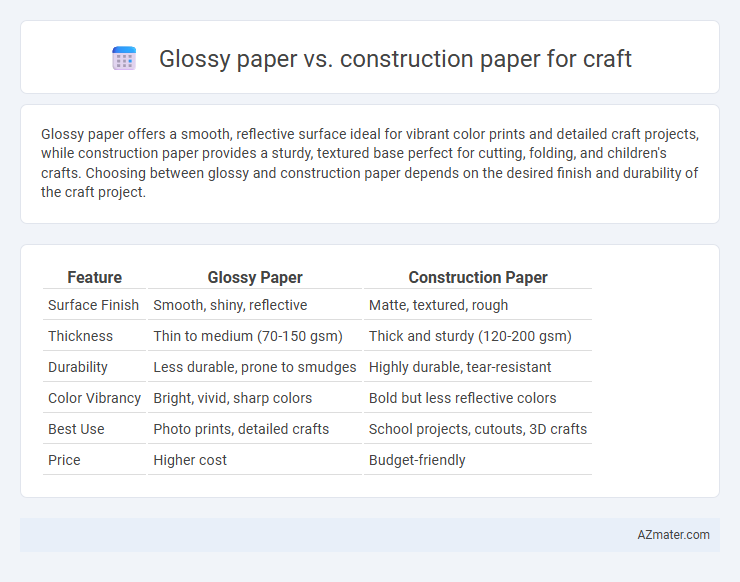Glossy paper offers a smooth, reflective surface ideal for vibrant color prints and detailed craft projects, while construction paper provides a sturdy, textured base perfect for cutting, folding, and children's crafts. Choosing between glossy and construction paper depends on the desired finish and durability of the craft project.
Table of Comparison
| Feature | Glossy Paper | Construction Paper |
|---|---|---|
| Surface Finish | Smooth, shiny, reflective | Matte, textured, rough |
| Thickness | Thin to medium (70-150 gsm) | Thick and sturdy (120-200 gsm) |
| Durability | Less durable, prone to smudges | Highly durable, tear-resistant |
| Color Vibrancy | Bright, vivid, sharp colors | Bold but less reflective colors |
| Best Use | Photo prints, detailed crafts | School projects, cutouts, 3D crafts |
| Price | Higher cost | Budget-friendly |
Introduction to Glossy and Construction Paper
Glossy paper features a smooth, shiny coating that enhances color vibrancy and is ideal for high-quality photo printing and detailed craft projects requiring a polished finish. Construction paper is a thick, rough-textured paper often used in schools and art projects for its durability and wide range of bold colors, making it perfect for cutting, folding, and layering. Understanding the different textures, durability, and finish of glossy and construction paper helps crafters choose the best material for specific artistic applications and desired visual effects.
Defining Glossy Paper: Features and Uses
Glossy paper features a smooth, shiny surface coated with a layer that enhances color vibrancy and detail, making it ideal for high-quality photo prints and detailed craft projects. Its resistant finish helps prevent smudging and water damage, which is beneficial for projects requiring durability and a polished look. Common uses include photo albums, greeting cards, and promotional materials where a professional, eye-catching appearance is desired.
Understanding Construction Paper: Characteristics and Applications
Construction paper features a coarse texture and is typically colored with vivid pigments, making it ideal for children's crafts and school projects. Its thickness and absorbency allow for easy cutting, folding, and gluing, supporting a variety of artistic techniques without smudging or tearing. Widely used in collage-making, paper sculptures, and teaching aids, construction paper offers durability and flexibility that enhance creative expression.
Texture and Finish Comparison
Glossy paper offers a smooth, shiny finish that enhances colors with a vibrant, reflective surface, ideal for detailed, polished craft projects. Construction paper features a rougher texture with a matte finish, providing better grip for adhesives and suitability for cutting and layering in hands-on crafts. The choice between glossy and construction paper depends on whether a sleek, professional look or a tactile, durable surface is desired for the craft application.
Versatility for Different Craft Projects
Glossy paper offers a smooth, shiny surface ideal for detailed craft projects requiring vibrant color and a polished finish, such as photo collages or greeting cards. Construction paper provides a sturdy, textured base perfect for cutting, folding, and layering in projects like paper sculptures and classroom crafts. The choice between glossy and construction paper depends on the desired durability and visual effect, making each suitable for different types of creative applications.
Color Vibrancy and Retention
Glossy paper offers superior color vibrancy and retention due to its smooth, coated surface that reflects light, enhancing the brightness and sharpness of printed or painted colors. Construction paper, with its rough, porous texture, absorbs pigments more readily, often resulting in duller colors that may fade faster over time. For crafts requiring long-lasting, vivid visuals, glossy paper is the optimal choice, while construction paper suits projects where texture and ease of drawing are prioritized.
Durability and Strength in Crafting
Glossy paper offers a smooth, coated surface that resists moisture and smudging, enhancing its durability in projects involving paint or markers. Construction paper, made from thicker, fibrous pulp, provides superior strength for folding and cutting, making it ideal for structural crafts like models and decorations. While glossy paper excels in visual finish and moisture resistance, construction paper outperforms in physical sturdiness and tear resistance during handling.
Ease of Cutting, Folding, and Gluing
Glossy paper offers a smooth surface that is easier to cut cleanly but can be slippery when folding, potentially causing less precise creases compared to construction paper's textured finish. Construction paper folds crisp and holds creases sharply, making it ideal for intricate folds, while glossy paper may resist bending and crack when folded sharply. For gluing, construction paper absorbs adhesives well, ensuring strong bonds, whereas glossy paper's non-porous surface can cause glue to dry slowly or slide, requiring more careful application.
Cost and Accessibility
Glossy paper typically costs more than construction paper due to its coated surface, which enhances color vibrancy and durability but raises production expenses. Construction paper is generally more affordable and widely accessible, making it a popular choice for basic craft projects in schools and homes. Budget-conscious crafters and educators often prefer construction paper for bulk purchases because of its lower price and availability in various colors.
Choosing the Right Paper for Your Craft Project
Glossy paper offers a smooth, shiny finish ideal for vibrant prints, detailed images, and photo crafts, enhancing color intensity and sharpness. Construction paper, made from sturdy, textured material, provides durability and is perfect for cutting, folding, and layering in children's crafts and school projects. Selecting the right paper depends on project goals: choose glossy for visual impact and construction paper for tactile, hands-on activities.

Infographic: Glossy paper vs Construction paper for Craft
 azmater.com
azmater.com